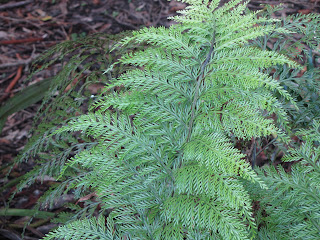There's something special that these nature patterns have in common.
 |
| Branching patterns |
 |
| Spiral patterns |
 |
| Wave patterns |
Within each we can see a repetition of shapes. For example, the shape of the smallest branchlet on the fern frond (circled in red) resembles the larger branch (circled in green) ..
This is described as 'self-similar', meaning the shapes are similar to each other even if they are of a different size. This repetition of self-similar shapes is one of the features of fractals and can also be seen in spirals, waves and other patterns. You can see more examples of self-similar shapes and patterns in the photos below.
Branching patterns aren't just found in plants, you might find them in waterfalls, rivers and estuaries. Notice how the smaller branches at the lower part of the waterfall look similar to the larger patterns at the top.
Spirals can be found in plants as well as snail shells. Each inner part of the spiral resembles the larger spiral.
And wave-like patterns can be found in the land and the sky as well as in water.
Here are some examples of other self-similar patterns in rock formations. Not all of the columns or layers are the same size but they are similar in shape.
Now it's your turn: Go on a nature hunt/scavenger hunt and look for examples of branches, spirals, waves and other examples of fractal patterns. Take photos to keep a record of your patterns.More about fractals and nature
Fractal geometry is the geometry of the natural world. In the natural world objects aren't squares, boxes, pyramids or cubes. There are few straight lines. Instead we find curves, wrinkles, and broken lines.
 |
| Ripples are an also example of fractals |
Fractals were named by Benoit Mandelbrot, a mathematician, in 1975. One question that fascinated him was 'how long is a coastline?' He realised that how long a coastline is depends on the way it is measured. For example, if we drive along a coast road we will get a measurement of the length of the coast road, but if we walk the same coastline along a path that is closer to the edge of the coast we will get a longer measurement, and if we walk right down at the shore around the rocks on the coastline the measurement would be greater still.
Fractal geometry provides a way of understanding the wrinkliness of a coastline, the branching of a tree and so on. If you want to find out more about the mathematics of fractals, the Fractal Foundation has a free online course.
More information on fractals
Fractal Foundation - https://fractalfoundation.org/
This is a great site for parents and teachers. There is a free online course which would be suitable for older children and it includes activities for younger children, such as this scavenger hunt idea https://fractalfoundation.org/resources/fractivities/scavenger-hunt/
Other blogposts about patterns
Symmetry in flowers https://explorediscovernature.blogspot.com/2018/12/natures-symmetry-flower-hunt.html
Hanging Clubmoss (an interesting example of branching) https://explorediscovernature.blogspot.com/2018/08/on-trail-hanging-clubmoss-curious.html










No comments:
Post a Comment